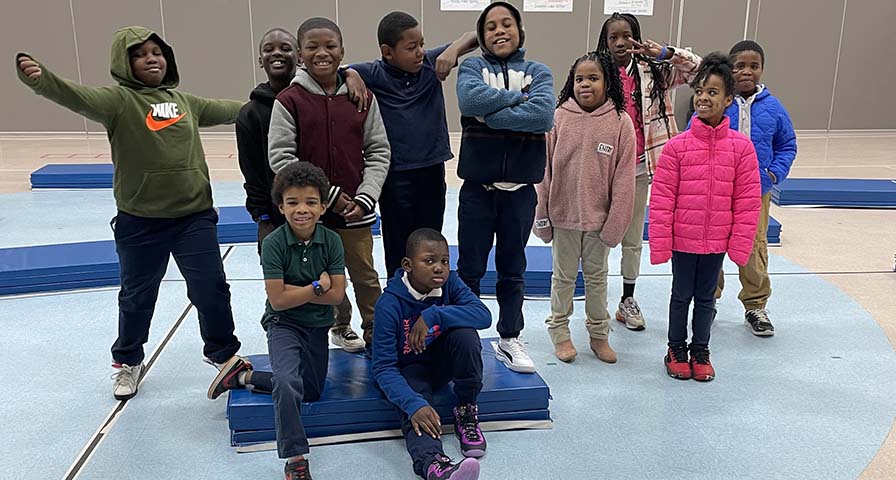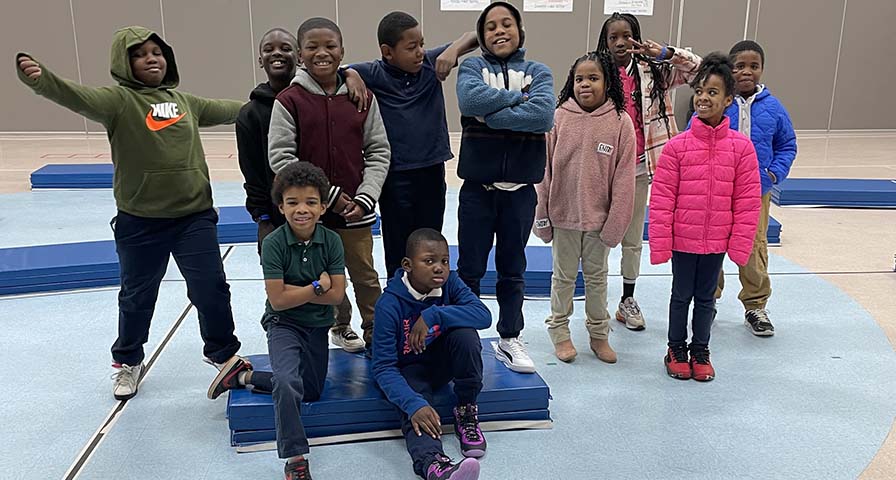
Eagle Fit Motivates 3rd Graders to Improve Fitness, Social Skills and Academic Readiness by Using Heart Rate Monitors to Promote Physical Activity
A before-school program at one of the nation’s largest school districts combines physical activity and IHT ZONE heart rate monitors to prepare students for academic success.
And it’s working.
Eagle Fit, a program introduced in January, 2024 at Winding Springs Elementary in the Charlotte-Mecklenburg (NC) Schools, has already helped 3rd grade students improve scores on their most recent academic benchmark testing.
Participating students wear IHT ZONE heart rate monitors as they participate in the 30-minute morning session. Students participate in different activities that range from team-building, interaction and exercise at different intensity levels.The activity gets neurons firing, allowing students to better focus on what they’re learning.
“(On March 27) in our before-school movement program, the teacher stopped me and told me about how a few of the students did on their recent benchmark testing,” Health & PE Resource Teacher Andrew Romberger said in late March. “They went up 36, 31 and 18 points. It’s remarkable to see gains and jumps (like that) from 1 test to the next. And, the students are feeling better.”
Off to a Flying Start
Winding Springs’ Eagle Fit program focuses on 13 third- and fourth-grade students who teachers felt would benefit socially and academically from more physical activity. The program meets every day before school from 8-8:30am. With teacher guidance, students take part in a fast-paced session that blends social skills with purposeful physical activity.
“We have students with lots of different activity levels and backgrounds,” Romberger said. “We’ve had to build relationships so we can get the most out of them in one setting. It depends on the activity and what their heart rate is, but they can do cardio and muscular strength activities and things to improve their hand-eye coordination.”
After picking up their IHT ZONE heart rate monitors, students go through a series of individual and group fitness activities and challenges. Friday often includes different “Guinness Book Challenges,” where students can compete to record top scores from a list of activities including:
- Most basketball passes in 60 seconds;
- Most socks on one foot in 30 seconds;
- Most Jumping Jacks in 30 seconds;
- Most knee-to-elbow touches in 30 seconds; and
- Fastest time to match emoji pairs
Romberger, fellow H/PE Resource Teacher Keith Kraemer and district Health and PE Specialist Jenn Vedder saw the need for a program that adds physical activity to the school day. Vedder, from her teaching days in Virginia Beach, Va., remembered how the IHT ZONE helped her PE and Adapted PE students then and put together a plan to add them in Charlotte-Mecklenburg.
“With my 9th grade PE classes, what I saw were kids who were much more in tune with how they were participating,” Vedder said. “They needed to get a certain number of minutes out of the 90-minute class in the yellow zone (moderate physical activity at an elevated heart rate) and the kids were desperate to do that.”
While Vedder didn’t want to create desperation among the Eagle Fit students, she thought the students would work toward something if they could see the feedback. The program does not require students to achieve minutes in yellow (moderate) or red (vigorous) heart rate zones.
“Students love the idea of a challenge,” Vedder said. “They may not understand their heart rate numbers, but we could give them a color to shoot for.”
As it stands, elementary students in North Carolina’s largest public school district – the 17th largest in the country – only get one 45-minute opportunity for physical education each week – at the end of the school day. That’s not enough daily movement.
“Kids need to play,” Romberger said. “It’s that simple.”
Getting Administrative Approval
Romberger and Vedder worked closely with Winding Springs Elementary Principal Dr. Matt Slota on a plan to inject more movement into the school day.
“It’s simple to me,” Slota said. “I’ve witnessed increasing movement work firsthand. However, most importantly, research is there to support the benefits and positive results/outcomes. If we activate the neurons in the brain, you’re better prepared and you’ll retain more information. I can attribute this not solely to us incorporating movement into our day, but it is a key contributor of the significant decrease in office referrals and overall incidents in our building the last two years.”
Slota understands the value of movement and made a significant change to the school’s daily calendar. He added 2 20-minute recess periods and placed them at specific points on the daily calendar.
“The recesses come before our ELA and math blocks,” Romberger said. “We want to get kids prepped and better ready to succeed. When you have someone like Dr. Slota, we can take things to another level. We don’t get turned down if we want to try movement-based learning. He gets it. He understands that being proactive is better than being reactive. There’s a trickle-down effect when you are not proactive.”
Slota joined Romberger, Kraemer, Vedder and Winding Springs Innovation Facilitator Emily Warnke at SHAPE America’s national convention in March where the team gave several presentations, including one detailing the Eagle Fit program.
Slota has always believed in movement as an effective learning – and classroom management – tool. Before he became principal at Winding Springs, he worked with Romberger and Kraemer to develop a program to inject movement as a way to decrease unwanted behaviors in students where he worked as an assistant principal. The three worked on a structure for the before-school program using “Brain, Body and Behavior or B3” as a guide. Slota did more than start and implement the before-school program at that school.
“I went as far as picking up these kids each morning,” Slota said. “My Principal renamed my truck ‘The Slota Shuttle’ because I was picking all these kids up each morning. About 6-7 kids worked with me before school for 30 minutes or so. The amount of positive impact it had changed my mind forever.”
Three campuses later, Slota acted quickly when the PE team came to him with their idea for Eagle Fit.
“I’ve worked at 3 different schools since where I have implemented the before-school program and knew when I became a principal it would be a major component that I implement. It was going to become our norm on how we do business–AKA school,” Slota said. “With my experiences, movement is one thing I believe in and has become a part of our culture. I am excited to see how we can continue to add movement and make it even more beneficial for Winding Springs.”
Eagle Fit and Beyond in 2024-25
When the current school year wraps up, Romberger and Vedder – no doubt with Slota’s support – will work on expanding the heart rate monitors across the district. Vedder’s already identified 9th grade PE classes where she wants teachers to introduce the IHT ZONE.
Romberger’s already thinking about what Eagle Fit will look like in 2024-25. The before-school program has been a success for the 3rd grade students. He wants to keep this year’s 3rd graders involved so they can mentor the 3rd graders who are selected for the program next year before spreading its wings.
“We are learning a lot,” Romberger said. “We’ve already seen some pretty cool successes. Going into next year we will have better plans and be able to better utilize everything based on what we’re doing this year.”
The team’s first goal is to continue to support classroom teachers who already use the IHT ZONE monitors throughout the day. Students put the monitors on when they get to school at 8:30 am and wear them until they leave for their special sections – PE, art, music – at the end of the day.
“An important part of my job as Innovation Facilitator is to help teachers find ways to incorporate movement organically into their academic content,” Warnke said. “Movement shouldn’t be limited to recess and PE.”
By encouraging classroom teachers to add movement to their regular lessons, staff can learn a great deal about how students respond to their heart rate throughout the day.
“I really want to focus on the social and emotional program for classroom teachers,” he said. “We want teachers to understand how they connect with monitoring the heart rate during class. If students are in the yellow or red (highly elevated heart rate normally associated with vigorous physical activity or very heightened emotions) in math class, what is going on? They are stressed to the point that their heart rate is elevated, so how can we help them get back to blue (calm)?”
Students can review their daily heart rate graphs with teachers and counselors and can learn to identify what causes their heart rate to spike at different times.
“With the social and emotional learning program with the monitors, that’s a game-changer too,” Romberger said. “The color is the instant feedback. We can’t see what’s going on inside and kids can sometimes hide how they are feeling. The monitor will give us insight, and that will be huge for our classroom teachers.”


